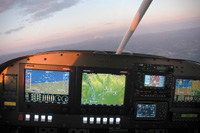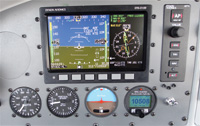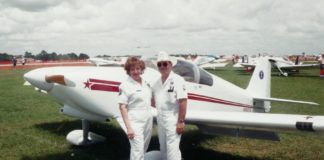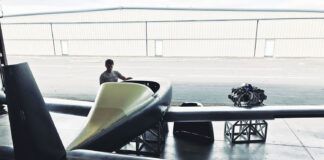The general trend in the last year is to increase capabilities, adding moving-map displays and introducing various forms of synthetic vision where basic maps were available before. A continued conjoining of EFIS and engine monitor functions is part of the mix, and buyers no longer worry as much about putting multiple systems and functions into a single box. Generally, today’s EFISes are amazingly reliable.
Let’s have a look at the lineup, which was current as of January. At the rate of development, new features—indeed, entirely new products—could well be in the news by the time you read this.
Advanced Flight Systems
In terms of product growth, AFS has set the bar. What began as a monochrome graphical engine monitor designed by Rob Hickman almost 10 years ago has morphed into some of the most popular systems sold today. Hickman’s angle has been to partner with “best of breed” subcontractors for key components instead of creating these things himself. For example, AFS sources its AHRS and remote magnetometer units from Crossbow, a well-known manufacturer of certified systems.

Advanced Flight Systems.
Advanced Flight was the first to offer inter-screen communication via an Ethernet cable, and indeed its new interfaces also use this technology. Last year AFS announced its new ADVANCED deck systems (we like to call it the AFS-4500) with a lot of expanded capability including a multi-function toggling joystick knob (as in the Garmin G1000) that lets you pan, zoom, select and enter all with one knob. The 4500 also has geo-referenced approach plates/charts, a much faster processor (that will allow for synthetic vision and forward-looking terrain displays), battery backup, an IFR moving-map database, a new flight director and interfaces to traffic systems, satellite weather and autopilots. It seems like every time I turn around, Hickman and his crew have introduced some new feature—big or small, obvious to the casual observer or not.
Speaking of autopilots, AFS has decided to partner with TruTrak instead of start out on its own. The AFS autopilot has advanced functionality for all phases of flight and is easily controlled through the EFIS itself. This includes everything from basic altitude hold and wing leveler all the way to flying coupled approaches. AFS has become one of the most popular EFISes for individuals wishing to build an IFR-capable airplane. The hardware behind the AFS is also rugged, and we can’t find any negatives to its products except that their popularity has occasionally made the lead times creep!
Aerosonic/Op Technologies
Aerosonic Corporation purchased Op Technologies in 2008 with the goal of certifying the FlightOp EFIS. At press time, I was unaware of the progress in certification, so I can’t comment on it. What I can comment on is the EFIS. The Op EFIS has been one of those situations where some customers have had great results and others have been spotty. Recently, a number of units have been removed for retrofit to competing units due to various issues, but these issues do not seem to be symptomatic of the entire product line.
To be fair to Aerosonic, we have not had the opportunity to evaluate many of the new products since the new ownership took over. Our exposure has been with customer support, and the company has struggled there.
Aspen Avionics
In 2007, Aspen created a buzz with the announcement of its Evolution Flight Display (EFD). Presented as the first low-cost (less than $6000) certified EFIS for easy retrofit, interest in the product was immense. Aspen underestimated the time it would take for the release of the finished product and missed its original marketed and advertised delivery date by a wide margin. It is now delivering units and expanding its certification list.
The company is delivering its expanded systems with additional functionality as well as MFD capabilities. My experience with Aspen is that early on the company really didn’t show any interest in Experimental homebuilders. This has been confirmed by colleagues who also received a cold shoulder at the outset. That being said, in the past year Aspen has realized there is indeed a good market for products in the homebuilt community and is showing an interest in working with builders.
As far as the EFIS itself goes, it looks in person every bit as good as the pictures, and it is one extremely well-built piece of equipment. It hasn’t taken off with homebuilders mainly due to cost. A base unit costs $5995, but to get an HSI or other expanded functionality, you’ll be looking at $9995. When compared to competitors in our market, you’ll notice you can get a lot more “bang for your buck” with many other units. Our Experimentals don’t need certified glass, but if having the paperwork makes you feel better, Aspen is a good choice.
Blue Mountain Avionics
Blue Mountain’s Greg Richter can be credited with introducing low-cost glass cockpit EFISes. It’s only fair to mention that BMA had a number of firsts that some have since forgotten. While many manufacturers are touting synthetic vision, BMA had it before anyone else in our market. It was also the first to have an EFIS that fit into a standard 3.125-inch instrument hole, the first with an advanced “high rate AHRS system,” the first with digital charts/maps, the first with an integrated autopilot and a number of other features.
Last year I was pretty harsh with BMA for losing its focus on customers and its perceived lack of customer support. Since then I have to say that BMA has listened and improved. While some older-generation systems still appear to have issues and customers can still be found removing those systems from their aircraft, BMA has done a lot to remedy that.
In the past year, BMA introduced a midsize EFIS called the EFIS/Two with a 6×9-inch screen. As with all other BMA products, it includes synthetic vision and integrates with its own BMA autopilot. Also, if you stopped by the BMA booth at Oshkosh in 2008, you may have seen its FLIR/thermal imaging camera. At a cost of just under $9000, this camera is pretty neat and turns night into day.
Currently BMA is alive and well, and even though its reputation has been scarred by a few missteps and miscues with customer service and reliability, it appears that the company is making progress and listening to its customers.
Chelton Flight Systems
In a year of new, there’s surprisingly little to report from Chelton Flight Systems, still reeling from the Direct-To Avionics debacle. Its Flight Logic EFIS is still available and still a darned good product. The company itself, however, has seen some fairly major changes. Chelton closed its long-standing facility in Idaho and merged with S-Tec in Texas. As part of this move, many personnel were laid off (including some key and experienced support people) so customer support has been a bit “challenging” at times.
There really weren’t any new products available to use in the Experimental market other than Chelton-announced WAAS-certified GPS, which also was/is heavily delayed and as of this writing is still not available. We do like the EFIS itself, and the Flight Logic EFIS created by Gordon Pratt many years ago was and remains the first EFIS to be certified with synthetic terrain. We don’t really know what’s on the horizon for Chelton and the Experimental builder.
Dynon Avionics
Like many of its competitors, Dynon has made a lot of changes in 2008. This past year offered a number of new additions to the Dynon line of products, though its core offerings of the small-screen D10 series and large-screen D100 series hardware remained mostly unchanged.

Dynon EFIS-D100 next to the company’s just-released AP74 autopilot control module.
Dynon did to a lot of work in the software, including plenty of detail improvements to the display—some of which came along with software Version 5, intended to support the firm’s new autopilot servos. Another welcome change was that Dynon finally figured out a way to expedite the updating of its software. While you still need to have a computer plugged into the EFIS (no flash drive or SD card) for the updates, the time it takes has been reduced dramatically.
With the autopilot (more about it and other autopilots for Experimentals next month), Dynon has added a couple of new expansion boxes, all fitting the same tall-rectangular form factor. The existing HS34 includes knobs for Heading, Course and a generic knob for Value, which can set the altitude alerter, barometric setting and other functions as determined by the software. I have always moaned about having to push a series of buttons and step through menus to change heading, barometric settings, dim the screen, and so on…but now the HS34 takes care of that. In addition, the HS34 acts as a pseudo-resolver for nav/coms and GPSes that require resolver input, and it enables an ARINC 429 communication protocol.
Big news for Dynon in the last 12 months is its next-generation panels with synthetic vision, but as yet we have no details on cost, functionality or date of delivery. We only know that the two screens—one at 7 inches diagonally and one at 10—will be “Dynon priced” and designed for future expansion. That’s a good thing. As nice and cost effective as the current product is, it is definitely processor and screen-resolution limited.
Garmin, Pushing Ahead
Garmin released a number of new products in the past year. While the G900X/G1000 family has now been out more than a year, the changes and enhancements made to that line of equipment is nothing short of phenomenal. The new Garmin SVT (synthetic vision technology) was officially launched at the homebuilding mecca (Oshkosh) last year, and raised the bar for synthetic vision. Unlike the Chelton wireframe terrain, Garmin has produced a smooth and shaded terrain that is pleasant to view.
Along with the basic picture, the SVT added a pile of other features such as a Velocity Vector/Flight Path Marker, Pathways (highway in the sky boxes), 3D obstacles, active and dynamic terrain warning, expanded autopilot integration and more. While the G900X system is one of the most expensive available, it’s also fully featured. What many people don’t realize is that the G900X system comprises entirely certified components. (They aren’t some dumbed down version of a TSO’d box, but the same and fully certified components that are in the certified airplanes.) It’s often hard to do a fair comparison with other systems for that reason, and coupled with the fact that it has two fully independent WAAS-certified GPSes for redundancy, two nav radios, two com radios, full audio panel, Mode S transponder with TIS traffic, full engine monitor, air data computer, and interfaces to just about every box that exists (DME, TCAS, satellite weather, etc.), you can see how it is hard to compare with any other similar setups, because there just aren’t any.
This year, Garmin also started delivering its delayed G600 certified EFIS package. As a single dual-screen system with PFD and MFD split in one package, it’s an excellent system for retrofit into certified aircraft. At a price of about $30,000, it’s on the high side for many homebuilt installations, but also has shown to be a good fit for some builders who want or need more than a basic EFIS, but either didn’t have room or could not afford the higher-end G900X. The G600 does not include any internal radios, but does naturally interface to most of Garmin’s other products as well as a variety of additional systems.
Grand Rapids Technologies
Grand Rapids finalized the delivery of its long awaited HX EFIS. With a new and faster processor than older models, the HX has much higher resolution than past GRT systems, and includes full synthetic vision. The screen is larger (offered in two sizes, up to an 8-inch-diagonal display) and brighter than previous models.
Grand Rapids already had probably the best and most numerous interfaces to other avionics units of anyone else, but the company has expanded that capability with interfaces to reduced-cost satellite weather and increased autopilot capabilities. It has also made the installation of its systems easier by using standard computer Ethernet cabling for screen-to-screen communication, and simplified USB interfaces for updates of software and downloads of data logging. Grand Rapids manufactures its own AHRS system, and now delivers as standard a dual-AHRS package with its EFIS, providing increased redundancy in a clean package.
The Sport system continues in production as an affordably priced EFIS with much of the capability of the higher end system, but aimed more at entry level or VFR builder. It is a powerful EFIS that still interfaces with many other units, but lacks the advanced interfaces, functionality and horsepower of its higher-end systems. One thing GRT does not do well is clearly distinguish the functional differences between its Sport system and the higher end HS/HX systems, so we’ll do it for you! The Sport is an excellent value-priced EFIS, call it a sort of “diet HX” or an “HX lite.” If you think you’re getting HX functionality for Sport prices, well, that’s incorrect. They are two completely different systems. While both are excellent, we would recommend the HS or HX systems in a robust IFR installation.
MGL Avionics
MGL has also started shipping its much awaited large screen Odyssey with a 10.4-inch-diagonal screen and the mid-size Voyager at 8.4 inches. Both EFISes continue with the functionality carried from the smaller Enigma. The EFISes all include a wire-frame synthetic terrain, moving-map capabilities, engine monitoring and interfaces to many external units. MGL is working on and will have satellite weather soon, and also has just completed an interface to drive the Trio Avionics autopilot servos directly.
We cannot report on how well this setup works yet, because as of this writing it was in beta test, and we know from experience that it takes a fair amount of testing prior to release to guarantee a smooth product. With the large-screen EFISes from MGL, there come mixed blessings. On one hand, the large screen is amazing to look at, but on the other MGL tends to use many bright colors and loads of data. This can result in a somewhat busy looking display, but the user can choose to declutter it a bit to help. The company’s new sawtooth altitude display, meant to mimic some high-end certified systems, is at the moment a bit of a miss. It’s not particularly pleasing to look at as far as an altitude tape, and the brightly colored alternating colors are distracting.
The front-mounted SD card slot is a hit. It makes uploading software a breeze, and MGL has figured out a way to make this so simple it’s almost funny! The company has taken a hard stance that having separate connectors on the back of the unit for each interface is the way to do things. While I can’t disagree with that general philosophy, I do think that using connectors like RCA audio-type plugs for data from an AHRS is not the best practice. Screw-down terminals also will work, but the rest of the industry has left those by the wayside years ago in favor of more modern and secure connectors. Still, MGL has a lot going for it, and if they’d modernize the connector situation, I think they would be well received.
TruTrak Flight Systems
TruTrak introduced its EFIS SG and began delivering the units last year. Its EFIS is the brightest available, and is now joined by the EFIS AP, which includes an internal autopilot.
You’ll first notice the display doesn’t look like the others. In place of the standard “tapes” there are semi-round instruments for airspeed/altimeter, and another first is the laid down DG/HSI display, which gives the pilot a different perspective of the directional indication. With a quick push of a button you can change the display to standard tapes.
The EFIS is available with varying options and now includes the choice of interfacing to a graphical engine monitor. TruTrak does not have a moving map or other interfaces, on purpose. The philosophy behind the TruTrak EFIS was to create the best, cleanest and easiest to read primary flight display. The reasoning is that at some point pilots can and will get overloaded with information in the cockpit, and having a good, solid PFD will provide the pilot with the best option. The EFIS does interface with GPSes and now the SL30, and allows the EFIS with its integrated autopilot to be a fully functional flight system. Keep an eye on TruTrak, because it also appears there may be more goodies in the pipeline from this well-established and respected company.
Parting Thoughts
There are a few things that I’d like to reiterate about this subject as a whole. People still don’t believe me, but I’ll repeat it anyway: Do not believe the manufacturers when they tell you their newest system will be available in a certain time frame. All of the major EFIS manufacturers have missed projected delivery dates—some of them grossly and repeatedly. If it’s not available today—and by that I mean that it’s on the shelf in a box, ready to hand to the UPS guy to bring to your door—do not plan on putting the future goodies in your panel unless you are at least a year away from flying. If you’re going to be flying in less than a year, pick something that is available now and stick with it.
Next, you really need to understand that all EFISes are not created equal. There are substantial differences under the skin that cause one EFIS to cost $3000 and another to cost $15,000. I’m not saying that the lower-cost units are inferior units overall. I’m simply pointing out that they’re not equal. Depending on your mission, needs, budget, panel space, personal desires and other factors…it’s all in play. There is no single system that will fit every builder’s requirements—true even as the category continues to develop. So, keep reading, pay attention to which companies take care of their customers, and don’t over buy. Those of you VFR-only pilots worried about whether your multi-screen EFIS will mate to a WAAS GPS for fully coupled approaches to zero-zero…Well, you guys need to get out more often.













